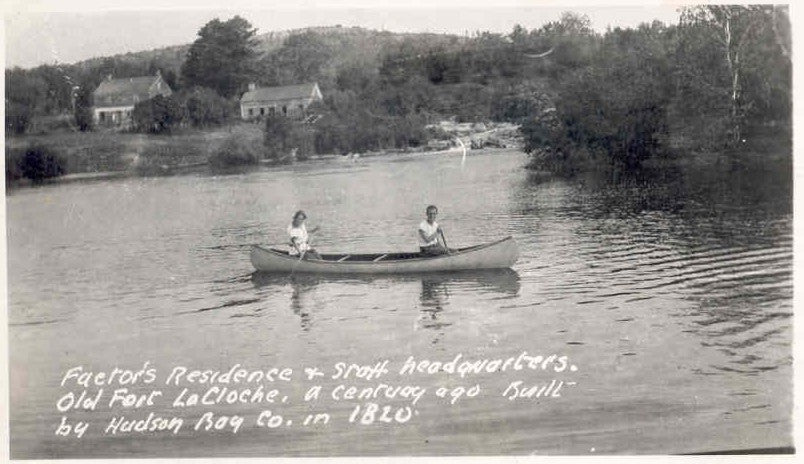The History of Fort La Cloche
Reprinted with permission from;
Culture, Heritage and Tourism
Hudson's Bay Company Archives
Archives of Manitoba
Prepared and completed in December 19, 1934
This place is mentioned as early as 1st September, 1761, by Alexander Henry, Senior, who then reports reaching:
"An island, called La Cloche, because there is here a rock, standing on a plain, which, being struck, rings like a bell."
It appears that no fort existed here when Henry passed, nor in 1789, when Roderick McKenzie visited the place. Ernest Voorhis in ‘Historical Forts and Trading Posts of the French Regime and of the English Fur Trading Companies’ published by the Department of the Interior, Ottawa, 1930, says the first post at La Cloche was built by the North West Company, probably around 1790, and that it was situated on the north shore of the North Channel, Georgian Bay, about ten miles east of the mouth of the Spanish River, on the direct route from Montreal to the west via the Ottawa River.
The name of La Cloche appears on a list of N.W.C. posts which existed in the year 1820, and on the amalgamation between that Company and the Hudson Bay Company in the following year, it was transfered to the latter, when Chief Factor John McBean - formerly of the N.W.C. - was placed in charge of the Lake Huron District with headquarters here, where he remained in control until he retired from the service in 1837.
Governor George Simpson in a letter to the Governor and Committee of the H.B.C. in London which is dated 5th September, 1827, states that La Cloche was:
"situated on the eastern bank of Lake Huron about half way between the mouth of the French River and Sault St. Marys."
and that it was at this time the principal and only permanent post in the Lake Huron District.
It is recorded that Governor Simpson passed the night of the 9th/10th May, 1828, here, when he was en route from Lachine to Michipicoten, arriving in a light canoe after sunset and leaving about 2 a.m. the following morning.
The establishment at Fort La Cloche in 1828-29 consisted besides Chief Factor John McBean, of one clerk and four labourers, and at this time the company were opposed here by two 'Free Traders', so that there were in all three trading posts in the immediate vicinity.
On 7th September, 1830, James D. Cameron - son of Chief Factor John Dugald Cameron of the H.B.C. arrived here:
"at the head of a Mission despatched by the Governor of Upper Canada for the purpose of opening a School at this place"
for the instruction of the natives in Christianity, and Chief Factor McBean states in his next annual report that this establishment was situated:
"at the end of the Company's garden on the border of the river, and on the same side with ourselves";
when he also makes it clear that he had rendered every possible assistance to the enterprise.
Governor Simpson writing to the Governor and committee on 10th August, 1832, states that the "Free Traders" who had occupied "regular posts" in opposition to the H.B.C. in the Lake Huron District, during the preceding years, had now abandoned them, and in consequence the Company's affairs here bore
"a more favorable aspect than they had done foe several years"
previously.
John McLean in his "Twenty-Five Years Service in the HB Territory" mentions visiting "the post of the Cloche" on 13th May, 1833, where he remained about two hours with Chief Factor McBean who entertained him kindly.
On 25th September, 1833, McBean accompanied by his family, left La Cloche for Lower Canada, where he had obtained leave to spend the ensuing winter, returning again to his charge on 6th June, 1834. During the intervening period, William Cowie was tranferred from Mississagi to the charge of the district at La Cloche, where he came under the superintendence of Chief Factor Angus Bethune, stationed at Sault Ste. Marie.
It is recorded that a number of deaths including one man, seven women and eight children, occurred at La Cloche between September, 1833, and June, 1834, owing to an epidemic of measles which had broken out in the district.
Chief Factor McBean, writing to Governor Simpson on 26th December, 1834, states that the "Fall Fisheries" at La Cloche had turned out better than ever before, and, that in consequence, they had been enabled to salt
"60 1/2 barrels of most excellent Trout and Whitefish"
which made them independent of all other kinds of provisions for the winter, so that they were able
"to assist the Natives in need".
The fall hunt in this area was also satisfactory.
The establishment at this post during the winter 1834-35 consisted of one Chief Factor, one boat builder, one blacksmith, four men and one apprentice boy.
Sir George Simpson, writing in August, 1836, states that at all the posts in the Lake Huron District
"there are petty traders closely watching every Indian as he comes in from his hunting grounds".
In the following year, 1837, Chief Factor McBean was relieved in charge of the Lake Huron District by Chief Factor Angus Bethune, who, in turn, was succeeded by Chief Factor John Dugald Cameron two years later. A clerk named James Anderson was apparently left in charge of the post during the short interim which occurred between the departure of Bethune and the arrival of Cameron.
Sir George Simpson in his "Journey Around the World" mentions the fact that he entered Lake Huron before sunrise on 15th May, 1841, and, that after dining
"on an island celebrated for a stone which, when struck, emits a musical or metallic sound"
he reached the Company's establishment of La Cloche from eight in the evening, which derived its name from
"the natural bell just mentioned".
In the summer of 1844, Chief Factor John D. Cameron was granted leave of absence prior to his retirement from the service and the management of the Lake Huron District now developed upon Chief Trader John Ballenden in addition to his previous charge at Sault Ste. Marie.
After visiting La Cloche in September, 1844, Ballenden left Alexander Wilson Buchanan, a clerk, in charge here for the ensuing winter, returning himself to Sault Ste. Marie.
In or about the year 1848, the Lake Huron District was once more rendered independent of the control of Sault Ste Marie and was now placed in charge of A. W. Buchanan, Mentioned above, who had been at the post of La Cloche since 1844, and now continued to reside here as headquarters of the district until May, 1850, when he was transferred to Sault Ste. Marie. Wemyss M. Simpson, a clerk in the service, now took charge of the Lake Huron District at La Cloche. On June 23, 1851, the latter proceeded to Sault Ste. Marie where he assumed control during the summer after the departure of Chief Trader A. W. Buchanan for the Northern Department and prior to the arrival of Chief Factor James Hargrave. In the meantime Henry Sayer and Edward Sayer were left in charge at La Cloche until Simpson's return in the autumn.
When writing to George Simpson from La Cloche on 30th December, 1851, Wemyss Simpson remarks that he had made
"two trips after the Spanish River Indians"
with satisfactory trading results, and that the whole band were expected at the post
"according to custom to have a feast"
on the following day (New Year's Eve). He then proceeds
"I only hope they may not die of indigestion from the tempting looking cakes that are being made for them."
The winter of 1851-52 was evidently a particularly severe one in the neighbourhood of Lake Huron, as Wemyss Simpson states in a letter to Sir George Simpson, which is dated 29th January, 1852, that the snow is deep and the frost very lasting, and, in addition, that the river was
"quite frozen to the falls a very unusual circumstance."
He then complains that he finds the winter at La Cloche nearly as dull as the previous one, but that
"having now become perfectly acquainted with the business of the place and the habits of the people"
he did not feel the same anxiety as the previous and, in fact, liked the place as much as any inland post although he often wished that he
"was back in the old Lachine office"
Sir George Simpson's headquarters - a few miles from Montreal.
In the next three years - 1852-54 - Wemyss Simpson proceeded each summer to Sault Ste. Marie in order to assume control there, whilst Chief Factor J. Hargrave was absent at the council at Michipicoten. Writing to Sir George on 13th August, 1853, Wemyss Simpson explains that they were in the throes of hay-making at La Cloche but that
"owing to the high water much trouble and difficulty was experienced in drying it".
It is interesting to note that Henry Moberley, who died as lately as 1931 at Duck Lake, Saskatchewan, when first appointed to the service as an apprentice clerk in December, 1853, was ordered to be stationed at La Cloche during the ensuing winter wjere he was to assist Wemyss Simpson in
"watching the trade in Lake Huron district".
He was however prevented from proceeding to that place until the month of February, 1854, owing to an attack of measles.
In 1855, Wemyss Simpson was appointed to succeed Chief Factor James Hargrave in charge at Sault Ste. Marie, being relieved at La Cloche by George Simpson McTavish in May of that year.
In the following year, 1856, the Indians of Lake Huron,
"owing to recent changes"
in their condition and habits and more especially from the fact that they were now collected at the village of Manitowaning, requested the Hudson's Bay Company to remove their establishment from La Cloche which they had frequented
"for more than half a century"
to some position nearer their village. Sir George Simpson in a letter to R.T. Pennefather, the Superintendent-General of Indian Affairs in this quarter, dated Lachine, 23rd August, 1856, states that in accordance with the wishes of the Indians, a new site had already been selected at the "Little Current" on the Manitoulin Island, but that as the Island was an Indian Reserve, it was necessary, before proceeding further
"to obtain the sanction of the
Department of Indian Affairs".
The reply to this was that the Governor in Council had approved of the Company taking possession
"of the necessary land at the Little
Current for the accommodation of a
Dwelling house and Store",
and upon this assurance building operations were accordingly commenced and plans prepared for the abandonment of La Cloche. But, as late as August, 1857, after the store at "Little Current" had been completed and was ready to receive the Company's goods, George S. McTavish received intimation from the Indian Commissioners that
"any further operations....must
be suspended until further orders",
and, he accordingly withdrew all the men, with the exception of one, whom he left to look after the store which had already been erected, pending further instructions.
The matter was again referred back by Sir George Simpson to the Superintendent-General of Indian Affairs, and, early in 1858, he was informed that an order had been approved by the Governor-General in Council
"withdrawing the Licence of Occupation of
the Little Current granted to the Company"
and, there was therefore no alternative left to them but to continue their headquarters for the Lake Huron District at La Cloche as formerly.



1 comment
The article offers an insightful overview of Fort La Cloche, detailing its historical significance as a strategic military site during the early stages of European settlement in Canada. The narrative effectively highlights the fort’s role in both protecting and expanding French and later British interests in the region. Visit us Telkom University Jakarta